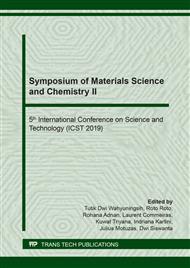[1]
Y. Xie, B. Yan, H. Xu, J. Chen, Q. Liu, Y. Deng, H. Zeng, Highly regenerable mussel-inspired Fe3O4@polydopamine-Ag core-shell microspheres as catalyst and adsorbent for methylene blue removal, ACS Appl. Mater. Inter. 6 (2014) 8845–8852.
DOI: 10.1021/am501632f
Google Scholar
[2]
H. Yan, H. Li, X. Tao, K. Li, H. Yang, A. Li, S. Xiao, R. Cheng, Rapid removal and separation of iron(II) and manganese(II) from micropolluted water using magnetic graphene oxide, ACS Appl. Mater. Inter. 6 (2014) 9871–9880.
DOI: 10.1021/am502377n
Google Scholar
[3]
E.I. Unuabonah, C. Günter, J. Weber, S. Lubahn, A. Taubert, Hybrid clay: a new highly efficient adsorbent for water treatment, ACS Sustain. Chem. Eng. 1 (2013) 966–973.
DOI: 10.1021/sc400051y
Google Scholar
[4]
Y.S. Al-Degs, M.I. El-Barghouthi, A.H. El-Sheikh, G.M. Walker, Effect of solution pH, ionic strength, and temperature on adsorption behavior of reactive dyes on activated carbon, Dye. Pigment 77 (2008) 16–23.
DOI: 10.1016/j.dyepig.2007.03.001
Google Scholar
[5]
G.Z. Kyzas, N.K. Lazaridis, Reactive and basic dyes removal by sorption onto chitosan derivatives, J. Colloid. Interface Sci. 331 (2009) 32–39.
DOI: 10.1016/j.jcis.2008.11.003
Google Scholar
[6]
R.O.A. de Lima, A.P. Bazo, D.M.F. Salvadori, C.M. Rech, D. de Palma Oliveira, G. de Aragão Umbuzeiro, Mutagenic and carcinogenic potential of a textile azo dye processing plant effluent that impacts a drinking water source, Mutat. Res. Toxicol. Environ. Mutagen. 626 (2007) 53–60.
DOI: 10.1016/j.mrgentox.2006.08.002
Google Scholar
[7]
I.D. Mall, V.C. Srivastava, N.K. Agarwal, Removal of orange-g and methyl violet dyes by adsorption onto bagasse fly ash—kinetic study and equilibrium isotherm analyses, Dye. Pigment 69 (2006) 210–223.
DOI: 10.1016/j.dyepig.2005.03.013
Google Scholar
[8]
K.V. Kumar, V. Ramamurthi, S. Sivanesan, Modeling the mechanism involved during the sorption of methylene blue onto fly ash, J. Colloid Interface Sci. 284 (2005) 14–21.
DOI: 10.1016/j.jcis.2004.09.063
Google Scholar
[9]
R. Han, J. Zhang, W. Zou, J. Shi, H. Liu, Equilibrium biosorption isotherm for lead ion on chaff, J. Hazard. Mater. 125 (2005) 266–271.
DOI: 10.1016/j.jhazmat.2005.05.031
Google Scholar
[10]
Y.-S. Ho, W.-T. Chiu, C.-C. Wang, Regression analysis for the sorption isotherms of basic dyes on sugarcane dust, Bioresour. Technol. 96 (2005) 1285–1291.
DOI: 10.1016/j.biortech.2004.10.021
Google Scholar
[11]
V.K. Gupta, I. Ali, T.A. Saleh, A. Nayak, S. Agarwal, Chemical treatment technologies for waste-water recycling‒an overview, Rsc. Adv. 2 (2012) 6380–6388.
DOI: 10.1039/c2ra20340e
Google Scholar
[12]
M. Rafatullah, O. Sulaiman, R. Hashim, A. Ahmad, Adsorption of methylene blue on low-cost adsorbents: a review, J. Hazard. Mater. 177 (2010) 70–80.
DOI: 10.1016/j.jhazmat.2009.12.047
Google Scholar
[13]
K. Rastogi, J.N. Sahu, B.C. Meikap, M.N. Biswas, Removal of methylene blue from wastewater using fly ash as an adsorbent by hydrocyclone, J. Hazard. Mater. 158 (2008) 531–540.
DOI: 10.1016/j.jhazmat.2008.01.105
Google Scholar
[14]
Z. Li, P.-H. Chang, W.-T. Jiang, J.-S. Jean, H. Hong, Mechanism of methylene blue removal from water by swelling clays, Chem. Eng. J. 168 (2011) 1193–1200.
DOI: 10.1016/j.cej.2011.02.009
Google Scholar
[15]
V.K. Garg, M. Amita, R. Kumar, R. Gupta, Basic dye (methylene blue) removal from simulated wastewater by adsorption using Indian Rosewood sawdust: a timber industry waste, Dye. Pigment. 63 (2004) 243–250.
DOI: 10.1016/j.dyepig.2004.03.005
Google Scholar
[16]
S. Altenor, B. Carene, E. Emmanuel, J. Lambert, J.J. Ehrhardt, S. Gaspard, Adsorption studies of methylene blue and phenol onto vetiver roots activated carbon prepared by chemical activation, J. Hazard. Mater. 165 (2009) 1029–1039.
DOI: 10.1016/j.jhazmat.2008.10.133
Google Scholar
[17]
T. Madrakian, A. Afkhami, M. Ahmadi, H. Bagheri, Removal of some cationic dyes from aqueous solutions using magnetic-modified multi-walled carbon nanotubes, J. Hazard. Mater. 196 (2011) 109–114.
DOI: 10.1016/j.jhazmat.2011.08.078
Google Scholar
[18]
P. Sharma, H. Kaur, M. Sharma, V. Sahore, A review on applicability of naturally available adsorbents for the removal of hazardous dyes from aqueous waste, Environ. Monit. Assess. 183 (2011) 151–195.
DOI: 10.1007/s10661-011-1914-0
Google Scholar
[19]
E. Grzkadka, S. Chibowski, Adsorption and elektrokinetic properties of the system: carboxymethylcellulose/manganese oxide/surfactant, Cellulose 19 (2012) 23–36.
DOI: 10.1007/s10570-011-9611-2
Google Scholar
[20]
A. Salama, N. Shukry, M. El-Sakhawy, Carboxymethyl cellulose-g-poly (2-(dimethylamino) ethyl methacrylate) hydrogel as adsorbent for dye removal, Int. J. Biol. Macromol. 73 (2015) 72–75.
DOI: 10.1016/j.ijbiomac.2014.11.002
Google Scholar
[21]
V. Alves, N. Costa, L. Hilliou, F. Larotonda, M. Gonçalves, A. Sereno, I. Coelhoso, Design of biodegradable composite films for food packaging, Desalination 199 (2006) 331–333.
DOI: 10.1016/j.desal.2006.03.078
Google Scholar
[22]
R. Wahyuni, Synthesis of glutaraldehyde (GA)-crosslinked carboxymethyl cellulose (CMC)-polyvinyl alcohol (PVA) film as adsorbent of methylene blue, Universitas Gadjah Mada, (2017).
DOI: 10.4028/www.scientific.net/kem.840.35
Google Scholar
[23]
H.S. Mansur, C.M. Sadahira, A.N. Souza, A.A.P. Mansur, FTIR spectroscopy characterization of poly (vinyl alcohol) hydrogel with different hydrolysis degree and chemically crosslinked with glutaraldehyde, Mater. Sci. Eng. C. 28 (2008) 539–548.
DOI: 10.1016/j.msec.2007.10.088
Google Scholar
[24]
E. Marin, J. Rojas, Preparation and characterization of crosslinked a films alcohol with waterprof properties, Int. J. Pharm. Pharm. Sci. 7 (2015) 242–248.
Google Scholar
[25]
O. Hamdaoui, Dynamic sorption of methylene blue by cedar sawdust and crushed brick in fixed bed columns, J. Hazard. Mater. 138 (2006) 293–303.
DOI: 10.1016/j.jhazmat.2006.04.061
Google Scholar


